Find those elderberries fast, before the deer and birds wipe them out! It’s prime time in Midwest U.S. to be harvesting Sambucus canadensis, which can occupy hardiness zones 4-9. While the whole plant, above ground has many uses, elderberries are the most exciting as a traditional, medicinal food.
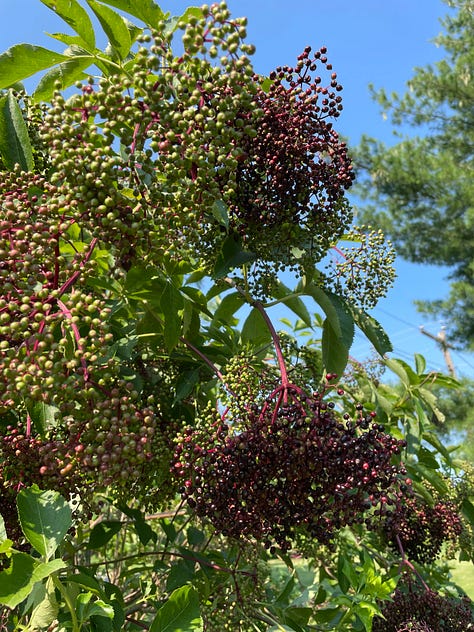
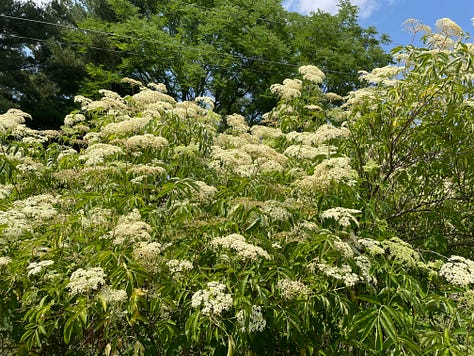
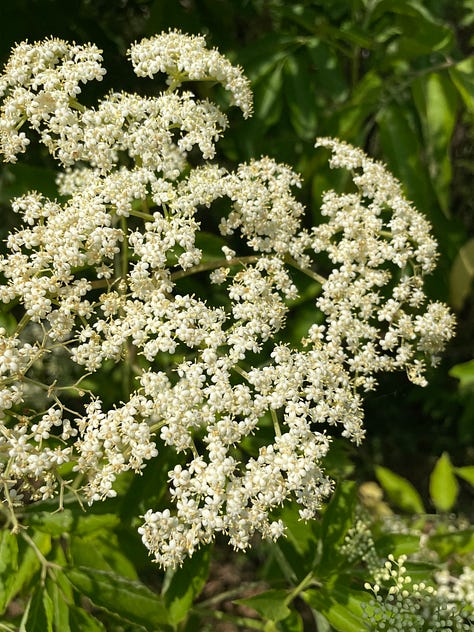
Sambucus nigra, is the native European variety of elderberry with a long tradition of medicinal use. This plant blooms earlier, and can grow into a tree with hard wood, which is valued for construction of smaller items. This species is widely cultivated, and has escaped to earn weed status in North America. (At weedom, we regard this as the plant version of earning a doctoral degree.)
Sambucus canadensis, the native North American variety, produces berries that are widely considered to be better tasting. It’s a smaller plant, and wonder weed which grows vigorously as a bush, and is more likely to spread by rhizomes.
There are numerous cultivars of each species, which feature various colored and scented flowers, many of which are ornamental. Leaf shape and flowers among these ornamental cultivars can vary radically. Hybrids of Sambucus nigra and Sambucus canadensis exist, although these plants differ in chromosome number. This and other barriers seem to inhibit the continuing reproductive potential of the hybrids.
Sambucus racemosa, red elderberry, is not so popular in the West, but has long been used as medicine in China. It appears to be possible for this plant, and S. nigra to hybridize, with at least one specimen identified in Sweden.
Do you have Sambucus nigra or canadensis? Or a hybrid? It’s OK, you can use the berries, and flowers of each for food and tea. Leaves, bark, flowers and berries have all been traditionally used as medicine.
First we’ll do the botany concentrating on the common elements of these two perennial, deciduous (shed leaves in the fall) plants. The Sambucus genus belongs to the Viburnaceae (a.k.a Adoxaceae) family. You will also see older references placing our elderberry bushes among the larger Caprifoliaceae, (honeysuckles), but DNA and morphological studies split that family apart sometime around 2016. Elderberry plants occur naturally as large bushes, with compound leaves, each of which sports generally oval shaped leaflets, each 5-15 cm. (2-6 inches) long, and with pinnately arranged veins. The margins of the leaves are sharply toothed. The top surface of each leaf is glabrous (hairless) while the underside may have very tiny hairs along the veins and sometimes between them. Once the stems bearing the leaves become woody, lenticles appear on the bark. These are little openings that allow for air circulation into the stems. Woody stems of elder have a white pith in the center which can be hollowed out. The bushes produce white to cream colored flowers, (with more color variety among the ornamental cultivars). Flowers ~0.7 cm. (1/4 inch) in diameter, are arranged in large umbels, and each bear 5 petals, 5 anthers and 3-5 stigmas (tops of the female structure, which capture the pollen). Berries on the umbels begin as green, hard, micro-pods, growing and ripening to a dark, almost black-purple, juice filled fruit.
Here are some of the ways to distinguish between our two species of edible interest:
Sambucus nigra is a larger bush, with generally fewer trunks, and this plant (with pruning) can also appear as a tree, reaching over 6 meters in height, (20 feet). Sambucus canadensis appears as a smaller 2 meter bush with more trunks.
The woody stems of Sambucus nigra have more abundant lenticles than those of S. canadensis.
The flowers of Sambucus niger have a musky, not sweet odor, and often a more creamy color, and bear 3 stigmas. Flowers of S. canadensis have 4-5 stigmas, usually are white, and of a more agreeable fragrance.
Berries of Sambucus canadensis appear as bright red for a time before they turn dark, and are considered to be more tasty than those of S. nigra, which have a more musky odor when cooked.
Leaves of Sambucus canadensis bear 5-11 leaflets, usually 7. Leaves of S. nigra bear from 3-7 leaflets, usually 5.
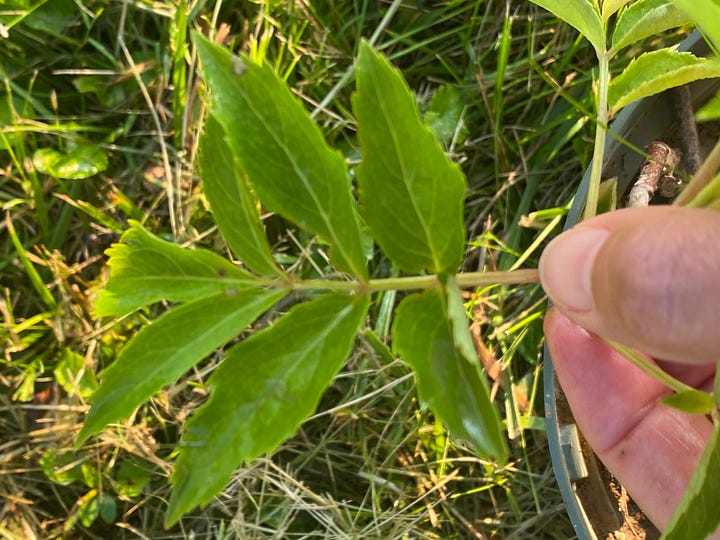
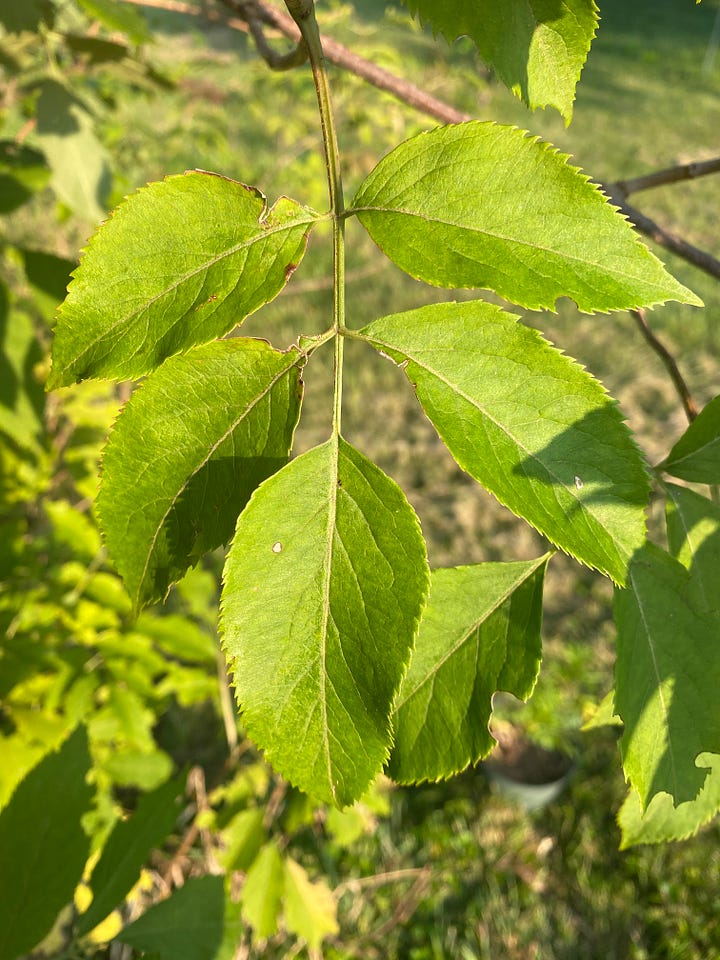
7 leaflets, baby S. canadensis bush, and 5 leaflets, weedom's S. nigra bush
Special note: The berries of a third common species, Sambucus racemosa stay red when ripe, grow as an upward pointing, grapelike cluster, are sour, and not as often used by people in the Western hemisphere. Eating these berries raw is more likely to produce a belly ache, nausea and vomiting, though it is not as severely toxic as some references imply. Cooking the berries seems to mitigate this problem and render it more usable as food or medicine. With the S. nigra and canadensis around, S. racemosa is likely more work than it is worth, but bear in mind that it does have utility. Every plant has an upper dose limit, and that of red elderberry is lower than black elderberry.
Though all parts of elderberries have many uses, we’ll stick with the berries, for now. These dark orbs contain about 7-11 % sugars (mainly fructose and glucose) as well as other carbohydrates such as fiber, pectin and cellulose. Protein content is a bit less than 3%, and the main fat content of the fruit is present in the seeds. Organic acids, such as citric, malic, shikimic and fumaric acids are present. The berries contain significant minerals such as potassium, calcium phosphorus, magnesium, zinc, manganese, and iron. Picking your elderberries in more pristine environments can minimize the heavy metals that these plants are also capable of accumulating in the fruit.
Anthocyanidins and other polyphenolic compounds account for the main biological activities for which elderberries are celebrated. Actual human trials have been conducted with favorable results, showing that use of elderberry fruit extracts were associated with reduced severity and duration of flu symptoms. In vitro trials showed that these extracts could inhibit H1N1 infection in cell cultures, at low concentrations. One of the antiviral mechanisms is the binding of 2 different flavonoids to hemagglutinin proteins on the viral envelope surface, which in turn inhibits binding of the virus to human cells. Another antiviral mechanism is inhibition of neuraminidase on the surface of influenza virus, by the binding of the elderberry constituent cyanidin 3-sambubioside, thereby interfering with replication processes. Indirect effects against viral infection are attributed to immune modulatory activity of elderberry affecting the production of the cytokine class of cell signaling molecules, e.g. interleukins, tumor necrosis factors, interferons.
Elderberry extracts showed in vitro inhibitory activity against human pathogenic bacteria such as MRSA, Pseudomonas aeruginosa, various Streptococcal pathogens of the respiratory tract, and Branhamella catarrhalis.
Anthocyanidins appear to be mostly responsible for the health supporting activity of elderberries, to which is attributed anti-aging, anti-inflammatory, antioxidant, and vasculature supporting qualities. These compounds also encourage apoptosis, (programmed cell death), and discourage metastasis of cancer. They’re also responsible for the dark purple-black color of elderberries.
Sambunigrin and prunasin are among the ‘famous’ cyanogenic glycosides produced in variable amounts among Sambucus nigra and canadensis. These occur in low amounts, with highest concentration in leaves, less in flowers and lowest in the berries. That which is present in the berries seems to be concentrated in the seeds, so that berry processing that separates out the seeds, or, alternatively does not crush them, will result in a more agreeable product that can be enjoyed in larger quantities.
Lectins are carbohydrate binding proteins which might be the most considerable contribution to potential toxicity and to allergies. These are proteins, present in many foods besides elderberry, such as grains, legumes and members if the night shade family (potatoes, tomatoes, eggplant). Certain lectins have N-glycosidase activity and can inhibit ribosome activity and stop protein synthesis, causing a cellular death syndrome, which is very bad for you. Lectins are protective constituents of plants, and they have a great deal of specificity for particular organisms or cell types. This is affected by transport parameters and by activity of their carbohydrate binding portions and their enzymatic portions. Remember: heating inactivates these proteins. Some foods (including many which make up a large part of our diets) were totally meant to be cooked :-D If you want more elderberry, cook it!! Other ways to enable increased portions is to separate the juice from the seeds, or avoid crushing the seeds during processing. The method at weedom is to heat up the berries with a bit of added water, simmer for 30 minutes, and squeeze out the juice in a tincture press, leaving the pomace with seeds behind.
uses a different method, which she describes below: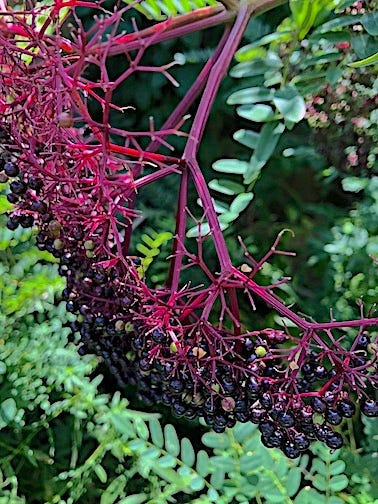
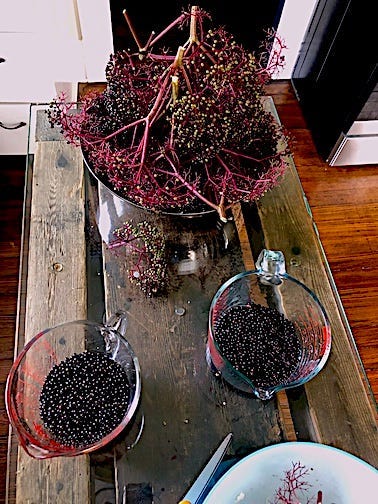

First, thanks to weedom for this opportunity to share something from
Brunette Gardens with weedom readers. I’m a fan of weedom’s detailed plant analyses and excited to bring you my recipe for elderberry oxymel.
This recipe does not call for sugar. That’s the unfortunate standard for elderberry syrup, and you can buy sugary commercial versions in just about any grocery store. But it’s not necessary to use sugar to preserve elderberry juice, and I have to ask: If you’re taking elderberry to boost your health, why undo that good move by adding sugar?
You might be wondering, “What’s an oxymel?” It’s a blend of honey and vinegar that was commonly used by our ancestors to preserve food. It’s also a flavor combination that dances between sweet and sour, a real palate pleaser. I’ve adapted this recipe from several I’ve tried, and we find it produces the most elderberry-rich flavor.
Elderberry oxymel
Ingredients
3 cups of elderberries, separated from the stems (see below)
1-2 cups of water
2-3 cups apple cider vinegar (see below)
2-3 cups honey
2 16-ounce sterilized mason jars or Weck jars if you have them
Remove berry clusters from the bush. Separate the berries from the green stems. Note the berries are edible, but the leaves, stems, and bark are not. You can use a comb for this, but I use my fingers.
Sterilize the mason jars by cleaning them with 1 part hydrogen peroxide to 3 parts water and then heating them in your oven on the lowest setting.
Pour the water and elderberries into a lidded pot. With the lid on, bring to a boil.
Remove the lid, lower the heat to medium-high, and squash the berries with a masher or spoon for about 15 minutes. If the mash becomes too dry, add more water. The amount of water you need depends on the juiciness of your berries. You want a deep purple juice and for the meaty parts of the berries to separate from the inner seed as much as possible.
Place the mash into a sieve strainer (if you don’t have one of these, check out the options on Etsy) so you can extract more juice from the fruit matter clinging to them.
Once strained, pour the juice into a measuring cup to see how much you have. Whatever the amount, match it with equal parts apple cider vinegar and honey. So for 2 cups of elderberry juice, add 2 cups of honey and 2 cups of vinegar.
Transfer the mixture back to the pot and bring to a boil.
Remove from heat for a few minutes and then carefully pour into your sterilized jars for storage. If you’re using Ball-style jars, you’ll hear a loud “pop” once the oxymel cools and the button pushes down for an airtight seal, but the oxymel will store fine in Weck jars as well without the pop effect.
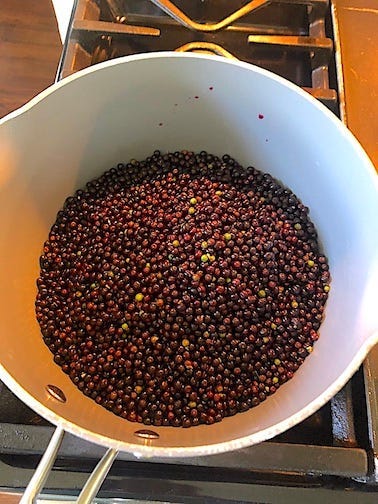
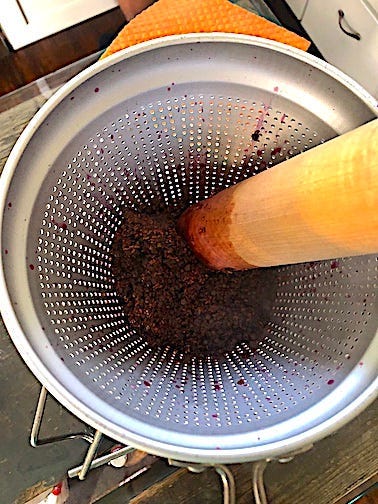
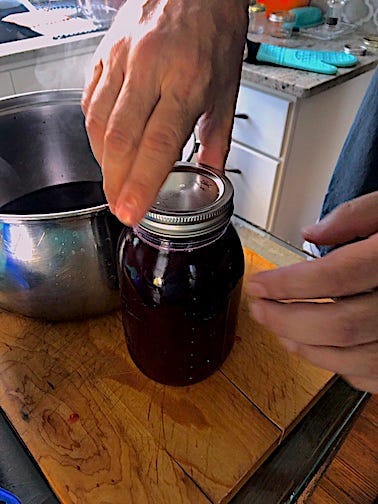
Some people add spices in Step 3, but we do not, as they detract from the sweet, deep flavor of the elderberries themselves.
Since we’re sterilizing the jars, boiling the oxymel, and using two natural preservatives (honey and vinegar), we do not then refrigerate the oxymel. We’ve kept it as long as six months on a storage shelf (cool, dark basement) unopened. Once you break the seal, move it to the fridge. However, if this preservation method makes you uncomfortable, by all means, give it a water-bath treatment.
We recently posted recipes for elderflower oxymel and jam as well, if you want to think about getting dual use out of your elderberry bushes next year.
This recipe contains affiliate links. If you purchase via the links, Brunette Gardens might earn a small commission, at no extra cost to you. Learn more on our Notices & Policies page.
Hope you enjoyed the weedom and Brunette Gardens collaborative post. Let us know what you think in Notes or comments. Thanks for hanging with us!!!
If you like us, please share us with your friends!
Where We Dig
1. Easley T. The Modern Herbal Dispensatory - a Medicine-Making Guide.; 2016. https://openlibrary.org/books/OL26933940M/The_modern_herbal_dispensatory
2. Tabaszewska M, Sikora E. The Effect of the Plant Stabilisation Method on the Composition and Antioxidant Properties of Elderflower (Sambucus nigra L.) Extract. Molecules. 2023;28(5):2365. doi:10.3390/molecules28052365
3. Wood M. The Earthwise Herbal - A Complete Guide to Old World Medicinal Plants. North Atlantic Books; 2008. https://openlibrary.org/books/OL12031143M/The_Earthwise_Herbal
4. Sambucus racemosa - Plant Finder. Accessed August 9, 2023. https://www.missouribotanicalgarden.org/PlantFinder/PlantFinderDetails.aspx?taxonid=278937&n=1
5. Przybylska-Balcerek A, Szablewski T, Szwajkowska-Michałek L, et al. Sambucus Nigra Extracts-Natural Antioxidants and Antimicrobial Compounds. Molecules. 2021;26(10):2910. doi:10.3390/molecules26102910
6. CABI. Sambucus nigra (elder). CABI Compendium. 2019;CABI Compendium:48259. doi:10.1079/cabicompendium.48259
7. Sambucus nigra (Black Elder, Elder, Elderberry, European Elderberry) | North Carolina Extension Gardener Plant Toolbox. Accessed August 8, 2023. https://plants.ces.ncsu.edu/plants/sambucus-nigra/
8. Sambucus canadensis (American Elder, American Elderberry, Common Elderberry, Elderberry) | North Carolina Extension Gardener Plant Toolbox. Accessed August 8, 2023. https://plants.ces.ncsu.edu/plants/sambucus-canadensis/
9. Rojas-Sandoval J. Sambucus canadensis (American black elderberry). CABI Compendium. 2020;CABI Compendium:48253. doi:10.1079/cabicompendium.48253
10. DerMarderosian A, Buetler J. Review of Natural Products. 8th edition. Lippincott Williams & Wilkins; Facts and Comparisons; 2014. https://openlibrary.org/books/OL27960482M/Review_of_Natural_Products
11. Hoffmann D. Medical Herbalism: The Science and Practice of Herbal Medicine. Healing Arts Press; 2003.
12. Hutchens AR. Indian Herbalogy of North America. Shambhala; Distributed in the United States by Random House; 1991. https://openlibrary.org/books/OL1567124M/Indian_herbalogy_of_North_America
13. saari cassi. Identifying Sambucus “nigra” in eastern North America. iNaturalist. Published 23:24:39 UTC. Accessed August 9, 2023. https://www.inaturalist.org/posts/19187-identifying-sambucus-nigra-in-eastern-north-america
14. Ganora L. Herbal Constituents, 2nd Edition - Foundations of Phytochemistry. Lulu Press, Inc.; 2021. https://openlibrary.org/books/OL35083771M/Herbal_Constituents_2nd_Edition
15. Maier K, Gladstar R. Energetic Herbalism - A Guide to Sacred Plant Traditions Integrating Elements of Vitalism, Ayurveda, and Chinese Medicine. Chelsea Green Publishing; 2021. https://openlibrary.org/books/OL34171771M/Energetic_Herbalism
16. Osman AG, Avula B, Katragunta K, Ali Z, Chittiboyina AG, Khan IA. Elderberry Extracts: Characterization of the Polyphenolic Chemical Composition, Quality Consistency, Safety, Adulteration, and Attenuation of Oxidative Stress- and Inflammation-Induced Health Disorders. Molecules. 2023;28(7):3148. doi:10.3390/molecules28073148
17. Mocanu ML, Amariei S. Elderberries—A Source of Bioactive Compounds with Antiviral Action. Plants (Basel). 2022;11(6):740. doi:10.3390/plants11060740
18. Elder toxicity. | Henriette’s Herbal Homepage. Accessed August 9, 2023. https://www.henriettes-herb.com/blog/elder-toxicity.html
19. Młynarczyk K, Walkowiak-Tomczak D, Łysiak GP. Bioactive properties of Sambucus nigra L. as a functional ingredient for food and pharmaceutical industry. J Funct Foods. 2018;40:377-390. doi:10.1016/j.jff.2017.11.025
20. Torabian G, Valtchev P, Adil Q, Dehghani F. Anti-influenza activity of elderberry (Sambucus nigra). Journal of Functional Foods. 2019;54:353-360. doi:10.1016/j.jff.2019.01.031
21. Hunan Zhong yi yao yan jiu suo, ed. A Barefoot Doctor’s Manual. Rev. & enl. ed. Cloudburst Press ; distributed to the trade in the U.S.A. by S. Greene Press; 1977.








Yaaaa zone 3 is just outside the hardiness range unless you can make a microclimate happen.
I planted some outside my orchard, in the reed canary grass surrounding a seasonal wetland. I find the flower to be one of the most beautiful things in the Midwest. But this is straddling zone three, and I have yet to see any where I live 30min south of the orchard, though 2hrs south around the Twin Cities they are abundant.